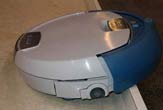Knife-Wielding Robots Could Soon Invade the Kitchen

If that Roomba vacuuming underfoot is any indication, robots are likely to become more of a household fixture in the years ahead. But if robots are ever to handle "edgier" tasks, say, like chopping up veggies in the kitchen, people will need to feel safe around domestic machines wielding sharp tools.
To gauge the kind of harm a robot could do to its owners, German researchers recently studied the mechanized stabbing and hacking of a blob of silicone, a dead pig's leg and – yes – a live human volunteer's arm, the study leader in fact.
"We want to understand the injury mechanisms of humans during robot-human impacts in order to find the best possible design and safety behavior for a robot," said Sami Haddadin, an engineer at the Institute of Robotics and Mechatronics of the German Aerospace Center (DLR).
The simulated soft-tissue damage revealed that, as one might expect, robots can deal out some lethal injuries. To prevent such accidents from happening, the researchers tested out a collision detection method that halts a cutting robot's unintentionally murderous motion.
As proof that the safety system worked when activated, Haddadin suffered nothing more than a scratch.
"I was absolutely sure that the system is capable of such outstanding performance, since I designed, implemented, and tested these methods," Haddadin told TechNewsDaily.
Previous studies conducted by Haddadin's group and others have looked at the blunt trauma heavy robots can cause when they bump into people – crash test dummies were battered in those trials – but this is the first time flesh cleaved by a machine has been assessed, Haddadin said.
Get the world’s most fascinating discoveries delivered straight to your inbox.
Choose your weapon
A jointed, flexible robotic arm built by DLR to be strong and light like a human arm was employed in the experiments.
Called a Lightweight Robot (LWR) III, the bright orange bot weighs 31 pounds (14 kilograms) and has a reach of more than three-and-a-half feet (1.1 meter). (A robotic arm similar to this operates on the International Space Station.)
The DLR engineers designed the robot to work around people, and German automaker Daimler AG has acquired some prototypes, Haddadin said.
He and his colleagues equipped their robotic arm with various sharp tools that can double as weapons. These included a scalpel, a kitchen knife, scissors, a steak knife, and – for those with more of a Mafia-bent to their violence – a screwdriver.
The scientists programmed the arm to stab at a block of squishy silicone and a leg from a dead pig. (Pig flesh is remarkably similar to human flesh, so it is used in vehicle crash tests and forensics, the paper noted.)
Besides puncture wounds, the researchers had the robotic arm cut the pig leg as well, as it might a roast in intended circumstances.
In many instances, the depths of the wounds indicated they would be deadly, the researchers said.
For example, before a low-level safety mechanism kicked in – which is actually meant to protect the robotic arm – the kitchen knife had penetrated about an inch-and-a-half into the silicone blob. That is deep enough to pierce into someone's heart through the chest or to cut to the bone in a forelimb.
Stay the blade
A so-called collision detection and reaction method, however, reduced the kitchen knife's plunge to less than a quarter of an inch, and in other cases prevented any apparent injury whatsoever.
The LWRIII has torque sensors in every joint, Haddadin said, which enables it to measure contact forces along its entire structure. When these forces change, the electronics system registers a collision with an object, and the robot's software can be set up to stop the arm's motion and go 'slack.'
For a robot in action, the method cannot distinguish between slicing a tomato as desired and safely sparing a baseball that has rolled onto the cutting board.
To make the system 'smart,' the authors wrote that robotic vision systems possibly using motion sensors could keep the machine alert about nearby people.
The most convincing test
With the success of the system on silicone and the pig leg, the researchers felt confident enough to try their collision detection system on a human subject – namely, their study's lead author, Haddadin.
He held his arm out in space above a table and then let the robotic arm with the safety system turned on play slasher. Only with its most Psycho-like stab at about 2.5 feet per second (.75 meters per second) did the knife-wielding robot succeed in scratching Haddadin's skin.
The researchers will continue to investigate means of preventing an encounter between blade-wielding robot and a person entirely, so the goals are both collision detection and avoidance.
"The ultimate goal of this research is to generate robot motions that are . . . not able to cause any harm to the human," Haddadin said.
The researchers presented their findings at the 2010 IEEE International Conference on Robotics and Automation in Alaska earlier this month.
• 5 Reasons to Fear Robots • Iron Man Technology Has Real-Life Analogs • Military Eyes 'Smart Camera' to Boost Robotic Visual Intelligence



